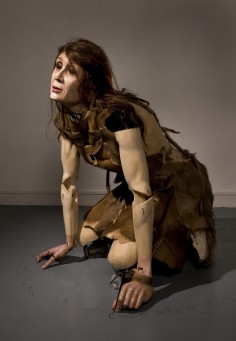Susan Adams
RECEIVER

source: artswalesorguk
Born in Kent, Susan Adams now works at her studio near Brecon and teaches on the Fine Art Degree programme at Cardiff Metropolitan University. Her practice embraces various media including painting, print, polychromed wood-carving and video.
After studying Painting at Norwich School of Art and the Slade Susan became Fine Art Fellow at Cheltenham College of Art. She then worked as Artist in Residence in India, the USA and the UK including at ArtsAcre Calcutta, Millay Colony New York, Welsh National Opera, Ynys Enlli (Bardsey Island), Oriel Mostyn and Shaftesbury Abbey. She was also selected to become the first Artist in Residence at Gloucester Cathedral.
Drawn to the uncanny, Susan is engaged with expressing a sense of narrative through art, making use of folk art, literature, film and children’s book illustration. She is interested in the exchange between the solid real, belief and the imaginary. An exploration of medieval sainthood led on to a collaborative project with contemporary voice-hearers in Wales.
Susan Adams has exhibited widely in the UK and internationally, recent venues in Wales include Oriel Mostyn, Oriel Mwldan, Attic Cardiff, MoMA Wales; as well as venues in London, Paris, Maastricht and Zagreb.
Susan Adams – ReceiverSusan will use the Creative Wales Award to loosen her control of the narrative in her art by engaging in a period of in-depth open-ended research, allowing free-flow narratives to emerge whose meanings are less clear to her.
She will begin by working collaboratively, opening creative dialogues with writers including Jo Mazelis and Lesley Saunders through conversations based on text and drawings. The initial dialogues with writers will coincide with an intense period of time expanding on the idea of drawing as a voice of the unconscious mind, the part of the mind that loves story and the ludic, possessing crescive powers wherein one image pushes forth the seed of the next.
The next stage will be to develop the collaborative process to a wider context of media, in which Susan will explore new technologies and consolidate her practice. She will bring together media in innovative combinations such as sound recordings of the vocalization of text with wall-drawing, projected animation with kinetic art.She will go and meet international artists engaging successfully with narrative such as Shary Boyle, Emma Talbot and Shana Moulton, to discuss their approach and build bridges.
.
.
.
.
.
.
.
source: susan-adamscouk
The role of the Receiver is to lie in wait for whatever it is – it, she or he is primed to receive. There is a suggestion of stasis or even of passivity and lack of choice as to what is being received. The automaton “Receiver” has something about it of the lost hermit, a recurrent figure in the work since 2001; like the artist the hermit is positioned inside but always outside society, watchful and reflecting back.
It was the experiences of a voice-hearer whom Adams interviewed – who said hearing voices felt like picking up peoples’ thoughts on the air – that brought about a connection in her imagery between the lone hermit looking heaven-ward and wireless technologies sending out endless streams of information. Now more than ever the ether could be said to hold intelligence that could be life-transforming. While masts call out from the hilltops, satellite dishes reach to the sky like boney believers hungry for a crumb of celestial knowledge. Adams writes:
“I am interested in the locations in which the organic and the mechanical find an uneasy relationship, as a child I remember being slightly terrified of my mother’s old monkey glove puppet made of fur and glass eyes.
bq. Becoming machine is something we may all be fearful of, loving technology that is cleverer than us as we do. Another delicious childhood anxiety of mine was the 1970s science fiction tv drama “The Changes” in which an ancient god uses pylons to broadcast directly into people’s minds the necessity to smash up all machines. On the other hand in George Orwell’s 1984 while the two main characters believe they have found complete freedom to explore each-other’s bodies in the wild woodland, that is where they are most likely to be under technological surveillance.”
The exhibition is supported by an Art Council of Wales Creative Wales Award and a Chance to Create Award funded by the Rural Development Plan for Wales 2007 – 2013 which is financed by the European Union and the Welsh Assembly Government.

